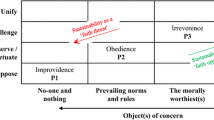Abstract
Social defense theory is used to explore the nature of anxiety and defense in sustainability initiatives. Taking seriously the suggestion that people use social institutions for both creative and defensive purposes, I examine how the organisational processes of a consortium case study seemed to be mobilised to cope with anxiety. The insights contained herein are useful if those working in that domain are to guard against the very wastefulness they ostensibly seek to redress. The data that inform the discussion come from a qualitative research project that sought to explore the psychodynamics of partnering for sustainability.
Similar content being viewed by others
References
Altman, N. (2005) Manic society: Toward the depressive position. Psychoanalytic Dialogues 15: 321–346.
Altman, N. (2007) Race, color, and the processes of racialization: New perspectives from group analysis, psychoanalysis, and sociology. Psychoanalysis, Culture & Society 12: 100–103.
Balbus, I.D. (2004) The dynamics of racial reparations. Psychoanalysis, Culture & Society 9: 159–185.
Benjamin, J. (1988) The Bonds of Love: Psychoanalysis, Feminism, and the Problem of Domination. New York: Pantheon Books.
Bollas, C. (1987) The Shadow of the Object: Psychoanalysis of the Unthought Known. London: Free Association Books.
Clarke, S. (2004) The concept of envy: Primitive drives, social encounters and resentment. Psychoanalysis, Culture & Society 9: 105–117.
Czarniawska, B. (2001) Having hope in paralogy. Human Relations 54: 13–21.
Diamond, M.A. (2007) Organizational change and the analytic third: Locating and attending to unconscious organizational psychodynamics. Psychoanalysis, Culture & Society 12: 14–164.
Emery, F. (1997) The next thirty years: Concepts, methods and anticipations. In: E. Trist, F. Emery and H. Murray (eds.) The Social Engagement of Social Science: The Socio-Ecological Perspective. Philadelphia: University of Pennsylvania Press, pp. 6–94.
Flinders, S.L. (2003) The internal struggles of aging. Psychoanalysis, Culture & Society 8: 258–262.
Hartman, S. (2005) Class unconscious: From dialectical materialism to relational material. Psychoanalysis, Culture & Society 10: 121–137.
Hirschhorn, L. (1988) The Workplace Within: Psychodynamics of Organizational Life. Cambridge, MA: MIT Press.
Hirschhorn, L. and Gilmore, T. (1992) The new boundaries of the ‘boundaryless’ company. Harvard Business Review, May–June, 68 (1): 104–115.
James, K. and Huffington, C. (2004) Containment of anxiety in organizational change: A case example of changing organizational boundaries. Journal of Organisational and Social Dynamics 4: 212–233.
Jaques, E. (1955) Social systems as a defence against persecutory and depressive anxiety: A contribution to the psycho-analytical study of social processes. In: M. Klein, P. Heimann and R.E. Money-Kyrle (eds.) New Directions in Psycho-Analysis: The Significance of Infant Conflict in the Pattern of Adult Behaviour. London: Tavistock, pp. 478–498.
Jaques, E. (1990) In praise of hierarchy. Harvard Business Review, Jan–Feb, 70 (3): 127–133.
Kaplan, L.J. (1978) Oneness and Separateness: From Infant to Individual. New York: Simon and Schuster.
Klein, M. (1959) Our adult world and its roots in infancy. Human Relations 2: 291–303.
Krantz, J. (1995) Anxiety and the new order. Paper presented at the International Society for the Psychoanalytic Study of Organizations Symposium, http://www.sba.oakland.edu/ispso/html/krantz.html, accessed 20 November 2006.
Lazar, R.A. and Lohmar, M. (2000) A search for new partners or an invitation to join a harem? The interplay of emotion and structure in the expansion process of a consulting firm. Paper presented at the International Society for the Psychoanalytic Study of Organisations Symposium, London.
Long, S. (2000) The internal team: A discussion of the socio-emotional dynamics of team work. Paper presented at the International Society for Psychoanalytic Study of Organisations Symposium, London.
Long, S.D. (2001) Conflict and co-operation: Two sides of the same coin. In: R. Wiesner and B. Millet (eds.) Management and Organisational Behaviour: Contemporary Challenges and Future Directions. Brisbane: Wiley, pp. 184–197.
Macy, J. (1995) Working through environmental despair. In: T. Roszak, M.E. Gomes and A.D. Kanner (eds.) Ecopsychology: Restoring the Earth, Healing the Mind. San Francisco: Sierra Club Books, pp. 240–259.
Maiteny, P. (2000) The psychodynamics of meaning and action for a sustainable future. Futures 32: 339–360.
Mawson, C. (1994) Containing anxiety in work with damaged children. In: A. Obholzer and V.Z. Roberts (eds.) The Unconscious at Work: Individual and Organisational Stress in Human Services. London: Routledge, pp. 67–74.
Menzies-Lyth, I. (1988) A psychoanalytic perspective on social institutions. In: E.B. Spillius (ed.) Melanie Klein Today: Vol. 2, Mainly Practice. London: Tavistock, pp. 284–299.
Mnguni, P.P. (2008) Mutuality, reciprocity and mature relatedness: A psychodynamic perspective on sustainability. Unpublished PhD Thesis, Swinburne University of Technology, Melbourne.
Obholzer, A. (1994) Fragmentation and integration in a school for physically handicapped children. In: A. Obholzer and V.Z. Roberts (eds.) The Unconscious at Work: Individual and Organisational Stress in Human Services. London: Routledge, pp. 84–93.
Obholzer, A. and Roberts, Z.V. (eds.) (1994) The Unconscious at Work: Individual and Organisational Stress in Human Services. London: Routledge.
Peltz, R. (2005) The manic society. Psychoanalytic Dialogues 15: 347–366.
Prins, S. (2002) Who's in charge here? Leadership dynamics in multiparty collaboration. Paper presented at the International Society for the Psychoanalytic Study of Organizations Symposium, Melbourne.
Roberts, Z.V. (1994a) The self-assigned impossible task. In: A. Obholzer and V.Z. Roberts (eds.) The Unconscious at Work: Individual and Organisational Stress in Human Services. London: Routledge, pp. 110–118.
Roberts, Z.V. (1994b) Till death do us part: Caring and uncaring in work with the elderly. In: A. Obholzer and V.Z. Roberts (eds.) The Unconscious at Work: Individual and Organisational Stress in Human Services. London: Routledge, pp. 75–83.
Speck, P. (1994) Working with dying people: On being good enough. In: A. Obholzer and V.Z. Roberts (eds.) The Unconscious at Work: Individual and Organisational Stress in Human Services. London: Routledge, pp. 94–100.
Thompson, S. (2005) Tentative utopias. Psychoanalysis, Culture & Society 10: 269–285.
Author information
Authors and Affiliations
Rights and permissions
About this article
Cite this article
Mnguni, P. Anxiety and defense in sustainability. Psychoanal Cult Soc 15, 117–135 (2010). https://doi.org/10.1057/pcs.2009.33
Published:
Issue Date:
DOI: https://doi.org/10.1057/pcs.2009.33




